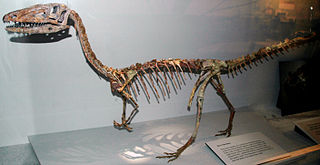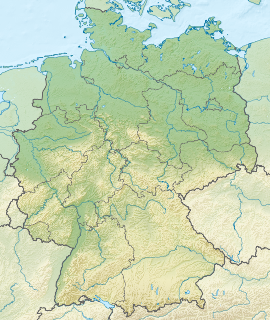
Coelophysis is an extinct genus of coelophysid theropod dinosaur that lived approximately 221.5 to 196 million years ago during the latter part of the Triassic Period in what is now the southwestern United States and also in South Africa and Zimbabwe.

The Moenkopi Formation is a geological formation that is spread across the U.S. states of New Mexico, northern Arizona, Nevada, southeastern California, eastern Utah and western Colorado. This unit is considered to be a group in Arizona. Part of the Colorado Plateau and Basin and Range, this red sandstone was laid down in the Lower Triassic and possibly part of the Middle Triassic, around 240 million years ago.

The Chinle Formation is an Upper Triassic continental geological formation of fluvial, lacustrine, and palustrine to eolian deposits spread across the U.S. states of Nevada, Utah, northern Arizona, western New Mexico, and western Colorado. The Chinle is controversially considered to be synonymous to the Dockum Group of eastern Colorado and New Mexico, western Texas, the Oklahoma panhandle, and southwestern Kansas. The Chinle is sometimes colloquially named as a formation within the Dockum Group in New Mexico and in Texas. The Chinle Formation is part of the Colorado Plateau, Basin and Range, and the southern section of the Interior Plains.

The Glen Canyon Group is a geologic group of formations that is spread across the U.S. states of Nevada, Utah, northern Arizona, north west New Mexico and western Colorado. It is called the Glen Canyon Sandstone in the Green River Basin of Colorado and Utah.

The Garita Creek Formation is a geologic formation in New Mexico that contains vertebrate fossils characteristic of the Carnian Age of the late Triassic.

The Montemarcello Formation is a Late Triassic (Carnian) geologic formation in Liguria, Italy. Fossil prosauropod tracks have been reported from the formation.

The Pajarito Formation is a geologic formation in eastern New Mexico and west Texas. It preserves fossils dating back to the Albian Age of the Cretaceous Period.

The Lossiemouth Sandstone is a Middle to Late Triassic age geological formation. It is exposed on the south side of the Moray Firth near Lossiemouth and near Golspie in Sutherland. Dinosaur remains are among the fossils that have been recovered from the formation.

The Bull Run Formation is a Late Triassic (Norian) stratigraphic unit in the eastern United States. Fossil fish bones and scales have been found in outcrops of the formation's Groveton Member in Manassas National Battlefield Park. Indeterminate fossil ornithischian tracks have been reported from the formation.

The Bell Ranch Formation is a Late Jurassic (Kimmeridgian) geologic formation in eastern and northeastern New Mexico and the western Oklahoma panhandle. Fossil theropod tracks have been reported from the formation.
The Midland Formation is a Mesozoic geological formation in the Culpeper Basin of Virginia. It is a sedimentary unit which formed in a short period of time between the first two basalt flows in the basin: the Hickory Grove and Mount Zion Church basalts. The most common rocks in the formation are dark reddish interbedded sandstones and siltstones, representative of fluvial (stream) environments. Rare but fossiliferous calcareous shale and limestone also occurs, representing recurring lacustrine (lake) conditions. The Midland Formation is considered equivalent to the Shuttle Meadow Formation of the Hartford Basin, the Feltville Formation of the Newark Basin, and the Bendersville Formation of the Gettysburg Basin.

The Nugget Sandstone is a Late Triassic to Early Jurassic geologic formation that outcrops in Colorado, Idaho and Utah, western United States. Fossil theropod tracks have been reported from the formation.

The Plattensandstein is a Middle Triassic (Anisian) geologic formation in southern Germany and northern Switzerland. Fossil theropod tracks have been reported from the formation.

The Sloan Canyon Formation is a late Triassic geologic formation exposed in northeastern New Mexico. Fossil theropod tracks have been reported from the formation.

The Tomanová Formation is a Late Triassic geologic formation in Poland and Slovakia. Fossil theropod tracks have been reported from the formation.

The Mesa Rica Sandstone is a geologic formation in Oklahoma and New Mexico. It preserves fossils dating back to the Cretaceous period.

The Sheep Pen Sandstone is a late Triassic geologic formation exposed in northeastern New Mexico. Fossil theropod tracks have been reported from the formation.

The Tucumcari Formation is a geologic formation in New Mexico. It preserves fossils dating back to the Albian Age of the early Cretaceous period.

The Benkersandstein is a geologic formation in Germany. It preserves fossils dating back to the Late Triassic (Carnian) period. Fossil theropod tracks have been reported from the formation.















